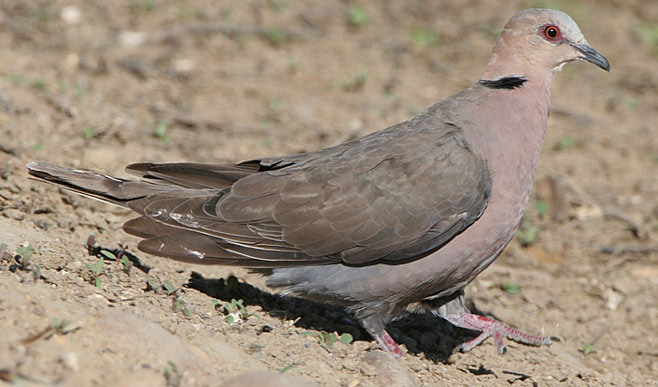Streptopelia semitorquata (Red-eyed
dove)
Grootringduif [Afrikaans]; Indlasidudu, Umakhulu
[Xhosa]; iHophe (also applied to Cape Turtle dove) [Zulu]; Haikonda (generic
term for turtle dove) [Kwangali]; Leebamosu, Leebana-khoroana (also applied to
Cape turtle-dove and Laughing dove), Leebana [South Sotho]; Bvukutiva [Shona];
Khopola, Nyakopo [Tsonga]; Roodoogtortel [Dutch]; Tourterelle à collier
[French]; Halbmondtaube [German]; Rola-de-olhos-vermelhos [Portuguese]
Life
> Eukaryotes >
Opisthokonta
> Metazoa (animals) >
Bilateria >
Deuterostomia > Chordata >
Craniata > Vertebrata (vertebrates) > Gnathostomata (jawed
vertebrates) > Teleostomi (teleost fish) > Osteichthyes (bony fish) > Class:
Sarcopterygii (lobe-finned
fish) > Stegocephalia (terrestrial
vertebrates) > Tetrapoda
(four-legged vertebrates) > Reptiliomorpha > Amniota >
Reptilia (reptiles) >
Romeriida > Diapsida > Archosauromorpha > Archosauria >
Dinosauria
(dinosaurs) > Saurischia > Theropoda (bipedal predatory dinosaurs) >
Coelurosauria > Maniraptora > Aves
(birds) > Order: Columbiformes > Family:
Columbidae > Streptopelia
 |
|
Red-eyed dove, Paarl Bird Sanctuary, South Africa. [photo Trevor Hardaker ©] |
The Red-eyed dove is common in many areas of southern Africa,
and has adapted very well to living with humans. It lives in most types of
woodland, especially alien tree plantations. It forages on the ground, looking
for seeds, nuts and bulblets. It usually builds it own nest out of twigs and
grass, but can also use stick nests made by other birds. The female lays 1-2 eggs, which
are incubated by both parents for 14-17 days, after which the chicks hatch. The
brood stays in the nest for 15-20 days, before leaving.
Distribution and habitat
Occurs across sub-Saharan Africa, including southern
Africa, where it is common in northern Namibia, northern and south-eastern
Botswana, Zimbabwe, Mozambique, Swaziland, Lesotho and South Africa. It has adapted very
well to the activities of humans, generally preferring woodland, especially
alien tree plantations,with pines (Pinus) Eucalyptus, Rooikrans
(Acacia
cyclops) or Port Jackson willow (Acacia saligna).
|
 |
|
Distribution of Red-eyed dove in southern Africa,
based on statistical smoothing of the records from first SA Bird Atlas
Project (©
Animal Demography unit, University of
Cape Town; smoothing by Birgit Erni and Francesca Little). Colours range
from dark blue (most common) through to yellow (least common).
See here for the latest distribution
from the SABAP2. |
Predators and parasites
Food
It eats a wide range of seeds, as well as flowers, nuts,
fruit and rarely insects. It forages on the ground, frequently under
trees. The following food items have been recorded in its diet:
- Plants
- seeds:
- cultivated plants
- sorghum
- maize
- millet
- cowpeas
- sunflowers
- grasses
- Pennisetum typhoides (Bullrush millet)
- Ricinus communis (Castor oil bush)
- Croton (Crotons)
- Acacia cyclops (Rooikrans)
- other
Acacia
- fruits
- Trema orientalis (Pigeonwood)
- Lantan camara (Cherry-pie)
- Vepris lanceolata (White-ironwood)
- Maytenus (Silky-barks)
- Morus alba (Mulberry)
- discarded apple pulp at juice extraction factories
- bulblets
- Cyperus esculentus (Nut grass)
- flowers
- Erythrina latissima (Broad-leaved coral tree)
- Toona ciliata (Indian-mahogany)
- ground nuts
- Invertebrates
Breeding
- The female usually makes the nest, using material collected by the male;
it consists bowl of twigs lined with grass. It may also use
nests of other birds, such as
crows,
thrushes and
egrets.
- Egg-laying season is year round, usually peaking from September-January.
- It lays 1-2 eggs which are incubated by both parents for 14-17 days.
- The chicks stay in the nest for 15-20 days.
Threats
Not threatened, in fact it has benefited greatly from human
disturbance.
References
-
Hockey PAR, Dean WRJ and Ryan PG 2005. Roberts
- Birds of southern Africa, VIIth ed. The Trustees of the John Voelcker
Bird Book Fund, Cape Town.
|
